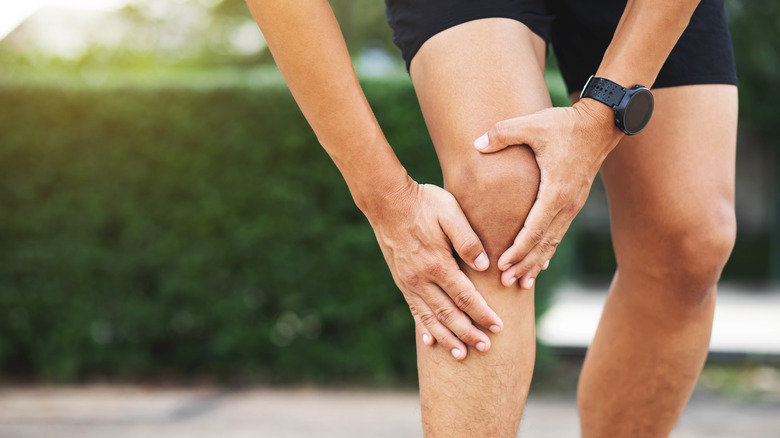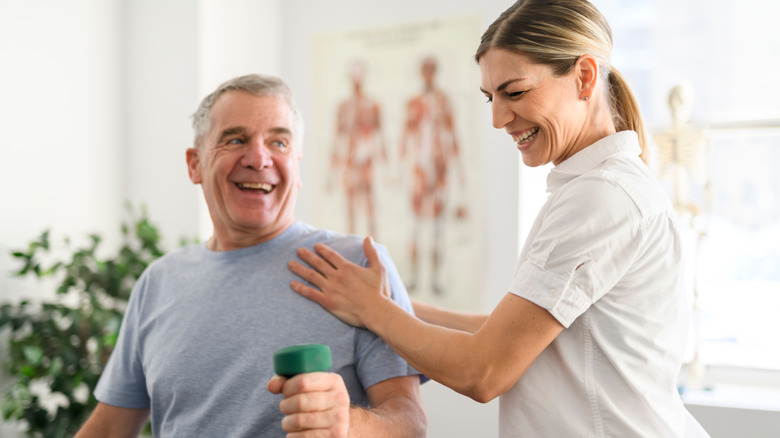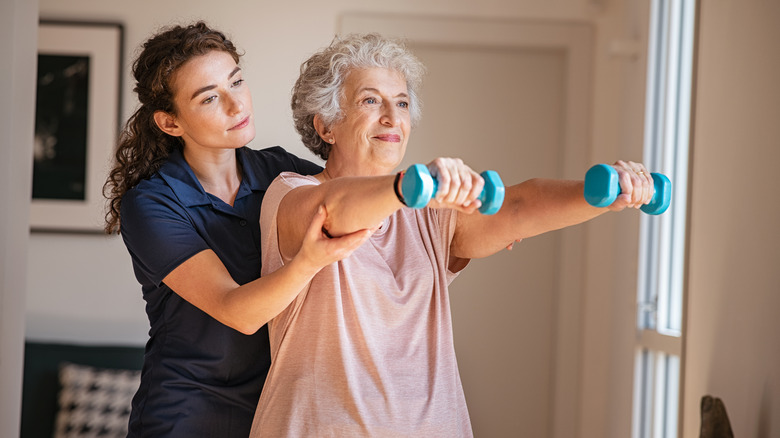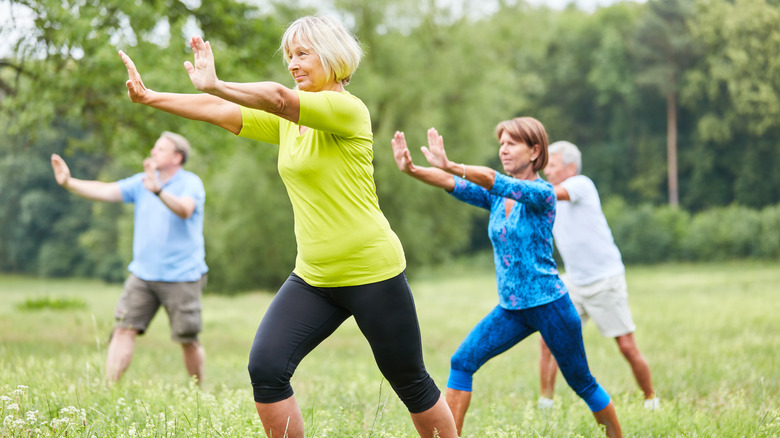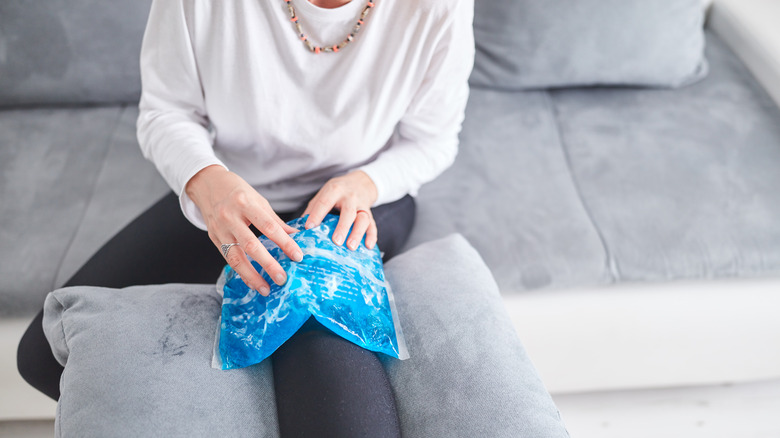11 Tips For Working Out When You Have Achy Joints
If you have aching joints, whether it be from an injury or a condition such as arthritis, working out might sound like the last thing you should be doing — why add further stress and risk further injury to an already compromised body part? But counterintuitive as it may seem, exercise is in fact one of the best things you can do to help manage joint pain, according to Harvard Health Publishing. Regular, well-designed workouts can help you maintain or increase flexibility and strengthen the muscles supporting your problem joints, preventing your condition from getting worse and potentially helping you avoid the need for surgery. And if you worked out regularly before your joints became a problem, you already know that regular exercise improves your mental and emotional well-being and quality of life.
But if you're still feeling gun-shy about working out with sore joints, consider this: Trying to protect your aching joints by avoiding movement isn't as safe as you think. In fact, not moving your problem joints can actually weaken them and further reduce their range of motion. This in turn can cause posture problems and other issues. Obviously, you shouldn't try to train for a marathon with injured knees or ankles — but regular workouts designed to accommodate your joints can reap huge benefits.
Good warmups are key
Warming up at the start of your workout is a good practice for any athlete. A good warmup prepares your body for the activity to come and increases blood flow to your muscles, which can reduce muscle soreness and your chance of injury. And as the Arthritis Foundation notes, warming up before a workout is especially critical if you have joint issues. If you're prone to stiff or sore joints, jumping right into a brisk run or vigorous game of tennis without warming up is asking for trouble.
Your warmup should ideally replicate, in a gentle form, the movements or actions of your main workout. For instance, according to the Mayo Clinic, if your planned workout is a brisk walk, your warmup should include several minutes of slow walking to ease your body into workout mode. For similar reasons, the Arthritis Foundation recommends a variety of dynamic warmup exercises that combine gentle stretches with movement. These can include hip circles (holding one leg out to the side and moving it in small circles while stabilizing yourself against a desk or table), arm circles (holding your arms out to the sides and moving them in increasingly large circles), and gentle lunges and twists to loosen the leg joints and back.
Applying heat can make movement easier
If you have stiff or injured joints, a helpful part of your warmup routine could be literally warming yourself up. According to the Arthritis Foundation, applying heat to cold, stiff joints — either through a warm bath or a hot compress — not only feels great, but increases blood circulation to sore tissues by dilating the blood vessels, which enables more oxygen and nutrients to circulate to injured tissues. This contributes to healing, relaxes and loosens stiff joints, and reduces pain.
To incorporate heat into your warmup routine, use warm — not hot — heat sources such as heating pads, warm towels, or a warm shower before you start your workout. (Using overly hot heat sources can cause burns, according to the Baton Rouge Clinic). The Mayo Clinic recommends applying heat for about 20 minutes before you start your warmup exercises. However, if your joint pain is actively flaring up or you have a recently injured joint that's inflamed, you should avoid applying heat and consider applying ice instead.
Stay away from these activities if you have joint pain
As noted by Harvard Health Publishing, regular exercise is essential for joint health, even for those experiencing joint pain. However, this doesn't mean that you should just resume your pre-injury or pre-arthritis workout routine or take up whatever new workout plan your friends are doing. Instead, you should listen to your body: While working through some mild discomfort may be fine, don't push yourself to the point of acute pain, and beware of exercises that could make your joint condition worse rather than better.
Among the exercises you should avoid if you have joint pain from arthritis are running, high-impact aerobics, and jumping rope — so in general, if an exercise requires you to take both feet off the ground, you should steer clear of it, since its jarring motions can strain all joints in your body (per Mount Sinai). And according to the U.S. News and World Report, even running on a soft surface or a treadmill puts a lot of stress on the joints throughout the body, and should definitely be avoided if you have knee problems. And if your knees are delicate, avoid deep squats, lunges, or other exercises that require deep knee bends.
If your shoulders hurt, avoid these mistakes when running
It's easy to see why running with knee pain is not a great idea. But because running bounces your whole body around, it can also potentially aggravate — or even cause — joint problems in other parts of your body. For instance, according to Activa Physiotherapy Ottawa, runners experience upper-body ailments such as neck and shoulder pain as frequently as more expected issues such as plantar fasciitis and shin splints. This can be puzzling to sore runners just trying to get a workout in: How can running cause pain in a body part that never even makes contact with the ground?
The root causes of shoulder and neck pain during running are tenseness and poor form. Thus, it's vital for runners to be mindful of their form and avoid rounding their shoulders or slumping. Ideally, your spine should be elongated and your body leaning slightly forward with your arms bent at a 90-degree angle by your sides. Relaxing your upper body by stretching your neck, shaking out your arms before you run, and letting them swing freely as you run will also stop you from inadvertently tensing up your neck and shoulders. And finally, you should relax your arms and neck with stretches before you start your run.
Range of motion exercises can help loosen stiff joints
If you have achy joints, you may have noticed you're not as flexible as you used to be. This is another area in which exercise can be helpful. For people with arthritis in particular, a consistent exercise routine can increase flexibility along with strength and endurance, according to the Mayo Clinic. And in particular, motion exercises specifically aim to improve flexibility in targeted joints.
Harvard Health Publishing recommends a handful of gentle exercises for improving your range of motion. For instance, you can work your shoulders with arm raises: Lying on your back with your arms at your sides, raise each arm slowly over your head, keeping your elbow straight and your arm close to your ear (as if you're doing the first half of a backstroke). Knee raises improve range of motion in your knees and are done from by raising a leg parallel to the floor while seated in a chair, holding it for a few seconds, then slowly lowering it. These exercises can be done safely at home, as long as they're done gently.
If your knees hurt, find out why to design the best workout
If you've spent any time around athletes (or people who fancy themselves to be athletes), you know there are countless ways to mess up your knees. And while standard pain management tools such as over-the-counter painkillers can be helpful no matter why your knees hurt, the same doesn't hold for exercise. According to Self, an exercise routine that works well for one person with knee pain may only make the pain worse for another.
This is because knee pain can have varied root causes, from arthritis to issues originating at other joints like the ankle or hip. Or, of course, sometimes the pain stems from direct injury to the knee joint itself. Thus, a workout that helps address one root cause might be unhelpful or even harmful if your knee pain is caused by something else. For this reason, you should consult with your doctor to understand the exact cause of your pain so you can design a workout that specifically targets your problem area.
Focus on strengthening the muscles around your achy joint
Achy joints are typically weak joints, which means the stress and strain of normal movement is often more than they can comfortably handle. But not moving your sore joint at all will only cause it to weaken and stiffen further, according to Harvard Health Publishing – and in any case, you may well find lying in bed all day to be logistically impossible. In short, the key strategy for joint health is use it or lose it — but the key is identifying the right way to strengthen your sore joint without triggering further pain or injury.
A useful strategy is to focus not so much on strengthening your troubled joint as on strengthening the muscles that support it, since when you move the affected limb, these muscles will likely have to do a lot of the heavy lifting that your sore joint can't do. For instance, physical therapist Corinne Croce told Self that she recommends glute activation and hip stability exercises, among others, for those with knee problems. Such exercises will help you take some strain off a sore knee while safely keeping it active.
Divide your workouts into short chunks if they strain your joints
For those who love the challenge and reward of a good workout, it can be frustrating trying to work through joint pain. You know exercise is good for you and you love the feel of a good cardio session, but even if the rest of your body is ready for a long bike ride or swim, that one problem joint can force you into settling for shorter, less satisfying routines.
Do not despair — according to the Mayo Clinic, you can still get in your cardio work without aggravating your joint problems. Indeed, even those with arthritis and joint stiffness can shoot for 150 minutes of moderately intense cardio work a week. But don't try to power through your desired workout as if your joint pain weren't there — listen to your body and honor its warnings if it tells you to stop. One way to get your workout in while being gentle to your joints is to split it up into multiple shorter sessions. So, instead of one 40-minute walk each day, you might want to shoot for two 20-minute walks instead.
Be mindful not to overextend your joints
As noted by Harvard Health Publishing, gentle exercises to improve your flexibility and range of motion are a good strategy if you have joint pain. But as in all areas of life, it's possible to have too much of a good thing. Doing too many reps, or even doing an appropriate quantity of the right exercises the wrong way, can make your joint problems worse. And according to the University of Tennessee Extension, even seemingly harmless movements that don't feel painful or strenuous in the moment can lead to bigger problems for your joints down the road.
Take, for instance, two common upper-body strength-training exercises: front and side lateral raises with dumbbells. In these exercises, you hold a dumbbell at your side and raise it with a straight arm up to shoulder level, either to your side or directly in front of you. But neither of these are intended to be extreme lifts — your arm should be parallel to the floor, no higher, at the end of each lift. Raising your arm past your shoulder can wear down your rotator cuff muscles and tendons over time and eventually cause injury. Even if bigger lifts and stretches feel easy and make you feel like you're getting in a more rigorous workout, stay safe and avoid the temptation.
These low-impact exercises are gentle on sore joints
By now, you should be convinced that gentle exercise is not only safe, but beneficial, if you have achy joints. As Mount Sinai explains, you should start slowly with short, easy routines before working your way up to more ambitious workouts, and avoid taking painkillers before you work out, since they can keep you from sensing any excessive strain or injury. In addition, if you have joint pain, you should avoid any forms of exercise that involve jarring motions and stay mindful of your form and posture during your movements.
And thankfully, there are plenty of fun, challenging, low-impact workouts that are safe to try even with compromised joints. According to Penn Health, water workouts including swimming and water aerobics offer solid resistance-based muscle training without putting pressure on your knees or hips. Biking or spinning also provide a vigorous workout while being gentle on your joints (wearing the right footwear will further help protect your joints by ensuring your feet are correctly positioned). And walking on a flat surface, tai chi, and yoga (no extreme positions, obviously) are also good choices.
Use ice with caution after your workout
As noted by The New York Times, ice packs have long been a go-to post-workout recovery tool to soothe tired muscles. As The Washington Post notes, many pro athletes and coaches still swear by them. In addition, they're also a central part of the standard treatment protocol for joint and muscle injury — rest, ice, compression, and elevation — and many medical professionals recommend ice as part of your post-workout cooldown routine if you have joint pain.
But other reputable healthcare professionals are no longer so sure that icing your joints and muscles after a workout is such a great idea. According to The New York Times, several recent studies have revealed that muscles actually heal more slowly after being iced than without ice treatments. This is because ice stops inflammation, but inflammation is actually a necessary stage of the healing process. "The body has three stages of healing: (1) inflammation, (2) repair, and (3) remodel," physical therapist and American Physical Therapy Association spokesman Robert Gillanders told The Washington Post. "Without inflammation, we do not proceed to the other stages of healing. So the use of ice to control inflammation makes no sense. Why stop the first stage of healing?" So don't overdo the ice if you do choose to use it — and consult your doctor to make sure it's the right choice for you.




